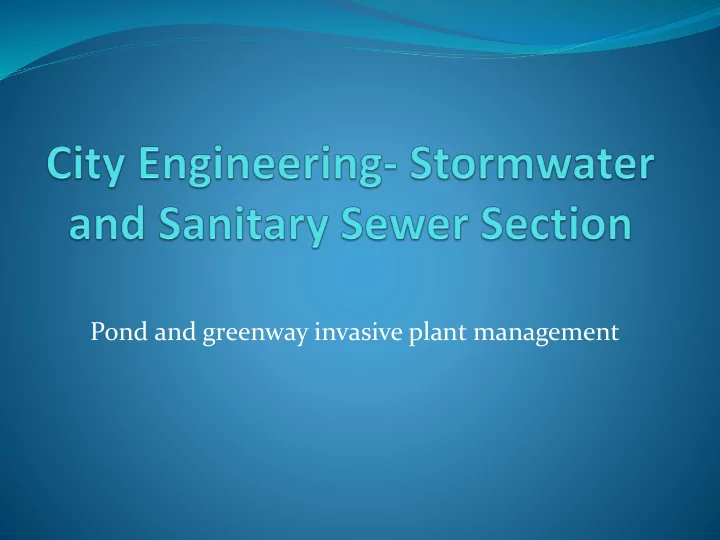

Pond and greenway invasive plant management
Background: Engineering owns and maintains approximately 1,200 acres of storm water drainage ponds and greenway corridors Vegetation varies- approx. 60% are prairie, many are mowed grass, some wooded, some wetland, etc Engineering must ensure these systems perform their primary function as storm water drainage and conveyance We follow Pollinator Taskforce recommendations to promote wildlife habitat- especially bee pollinator by reduced mowing and preventing invasive plants from spreading.
Pond and greenway map example Legend: Red: Prairie- no mow Green: Mow 1 June Yellow: Turf- Mow 2 x a year
Stormwater Ponds and Greenways for Pollinators
Process to determine how to manage: 1. Inventory all 1,200 acres. What is growing where? 2. Now we know what is growing. What is good and what is bad? 3. Define which invasive species to target & remove as much as possible and which areas are a priority. 4. Timing of invasive removal. 5. Communication.
Existing Prairie and Grass Meadow
Mowed grass
Unmowed (managed meadows)
Wetland Channels and Basins
How we do this… • Volunteers will continue to be an integral part of monitoring sites, removing, and treating invasive plants. • Operation Fresh Start will work with Engineering staff to remove invasive trees and plants , and treat with herbicide as needed.
Herbicide Use minimal amounts of herbicide only when other manual / mechanical methods do not work- example willows at outfall structures and Japanese knotweed Use a small amount of herbicide by cutting and treating rather than foliar application when possible Herbicide after mowing or prescribed burn is preferable
Why this is important? It’s important to keep a diversity of flowering plants for pollinator food and habitat.
Questions? Carissa Wegner Landscape Architect 1 City Engineering 608-261-9822 cwegner@cityofmadison.com
Recommend
More recommend